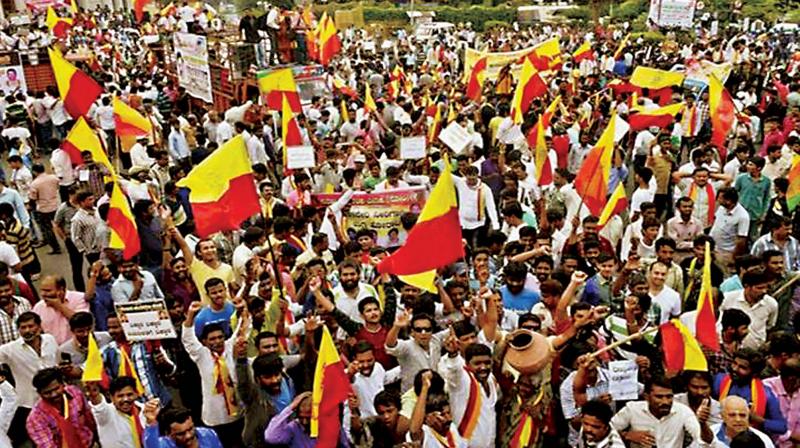Let's fly our flag high, not drag it into controversy

The controversy behind the concept of a state flag with Constitutional status is, quite frankly, baffling. The demand for a separate state flag has existed in Karnataka for several decades, reaching a head in the 1960s. Undercurrents of the movement had begun at the start of that century, when migrant workers from Tamil Nadu were brought to the state by the British to work in Bengaluru's textile mills. Sporadic movements to protect Karnataka's language and culture had sprung up across Karnataka, although these were badly in need of consolidation.
Resentment was felt as early as 1856 and the Karnataka Vidyavardhaka Sangha was established in 1890. Aluru Venkata Rao had, in 1903, made a bid for the integration of all Kannada-speaking regions. Supporters like Gudleppa Hallikeri, Siddappa Kambli, Rangarao Diwakar and K. Hanumanthaiah, the second (and immensely popular) Chief Minister of Karnataka took on the cause as well. It is also regarded as one of Hanumanthaiah's greatest achievements.
The unification of Karnataka, then the Mysore State, took place in 1956. Borders of several states were redrawn, based on linguistic demographics. This was a moment of triumph for the people; the areas that now comprise Karnataka had fallen under around 20 different administrative units. These included the princely state of Mysore, Nizam's Hyderabad, the Bombay Presidency, the Madras Presidency and Kodagu territory. Nearly 2/3 of what makes up Karnataka today fell outside the state's confines prior to unification.
Kannadigas, therefore, were a scattered lot, with their language being pushed into the shadows across these administrative units. Kannadigas living under the Nizam's rule were growing embittered, as they felt Urdu was being imposed upon them. Those who fell under the Bombay Presidency had to accept Marathi as the dominant language and Kannadigas in South Canara used Tamil as the main language. Rumblings of discontent, therefore, were hardly surprising.
However, despite the Unification, the prevailing sentiment remained one of discontent. The people felt that not enough was being done to support Kannada as a language. To them, Tamil and Telegu were still being given precedence over Kannada, in their own state. Celebrated Kannada writer, A.N. Krishna Rao, who also served as an editor of the Kannada Sahitya Parishath's publication Kannada Nudi (Kannada speech) launched a movement. An active, fiery proponent of Kannada, started a movement to promote the language.
Attended by stalwarts of Karnataka culture, a 1962 conference, aimed at protecting and promoting indigenous traditions was held in Mysuru. In 1964, the hoisting of flags from Tamil Nadu caused a stir. M. Ramamurthy, a Bangalore-based writer and activist, who is often lauded as a commander of the Kannada movement during the 1960s, went on a four-day padayatra to protest this. He realised, soon enough, that Karnataka did not have a flag to hoist.
This led to his designing of the yellow-and-red flag, which symbolises Arrishna (turmeric) and Kumkuma (vermillion), was an attempt at consolidating a defense against what was seen as a fundamental threat to local culture. The flag has been in use ever since, hoisted on important occastions like Karnataka Rajyotsava, as a symbol of the state's language and culture. It was never attended as a political weapon, neither did it stand for a separatist ideology. This is one of the reasons why we feel that the state flag deserves to receive Constitutional recognition.
Hindi is our national language and our national emblem is a symbol of India's sovereignty. Karnataka has its own emblem, the two-headed bird, Gandaberunda. Every state has its own language and emblem, despite which the unity and integrity of the nation has remained intact. Therefore, it would be incorrect to say that awarding Karnataka's flag Constitutional status will affect the overall peace of the nation. All we want is a flag that stands for Karnataka, its language, culture and heritage. And it must be said that nobody is compelled to hoist the State flag during important occasions. The demand for the flag symbolises our struggle for the recognition and preservation of our state and its culture.
Flag facts
- The Flag Committee was constituted on June 23, 1947. It held several meetings and studied the question in depth. After detailed deliberations it arrived at the decisions on July 14, 1947
- The National Flag of India should be made of hand-spun and hand-woven wool/cotton/silk khadi bunting.The National Flag should be rectangular in shape. The ratio of the length to the height (width) of the Flag shall be 3:2
- After India became Republic, the Indian Standards Institution (now Bureau of Indian Standards) brought out specifications of the National Flag for the first time in 1951 which were revised in 1964 with a view to completely changing over the dimensions of the flag to the metric system. The specifications were further revised on 17th August, 1968
- A person was prevented by the officials of Madhya Pradesh government from flying the National Flag at his factory premises as Flag Code - India did not permit it on private buildings by individuals except on special occasions. He moved the Delhi High court Court which ruled that individuals are free to hoist flag with reasonable restrictions laid by the government.
The writer is a Kannada activist

